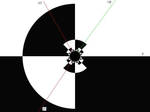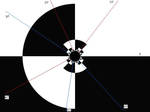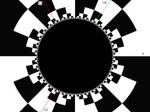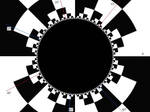ShopDreamUp AI ArtDreamUp
Deviation Actions
Before reading this journal I recommend my very dear readers to repeat the short articles 2 and 3 in my Chaotic series of fractal articles, especially because there been a typos, newly corrected, where the base and the exponent until now been confused  I also recommend you to check out the short article 9 in the above mentioned Chaotic series.
I also recommend you to check out the short article 9 in the above mentioned Chaotic series.
Special preperiodic cycles and acupuncture points
In part 1 we learned that rationals with even denominators are preperiodic under doubling. We have seen one example on that,
1/6, 1/3, 2/3, it’s shift map being 001. Now there are some special even numbers in the denominators, which are very special. Those even numbers are 2, 4, 8, 16, etc, expressed as exponentials of 2, as 2^1, 2^2, 2^3, 2^4, etc Example; 3/4, 1/8, and 5/16 of a whole turn. Let’s take the last one and perform the angle doubling;
5/16 -> 10/16 = 5/8 -> 10/8 – 1 = 5/4 – 1 = 5/4 – 4/4 = 1/4 -> 2/4 = 1/2 -> 2/2 – 1 = 1 – 1 = 0 -> 0 etc.
That is the orbit;
5/16 -> 5/8 -> 1/4 -> 1/2 -> 0.
We see they are preperiodic to period 1, or in other words, they go to a fixpoint.
Question: What’s the special with these angles?
Answer: They are exactly those angles, together with the angle 0, that in our four illustrations,




to the previous journal, as well in every image were binary decomposition is used, are denoted by the borderlines between the black and white areas that radiates from the circle, or the fractal. For those spots from where those lines radiates I, in my chaotic series, have invented the term “acupuncture points”. More about those acupuncture points can be read in especially article 3 and article 9 in this series.
Angle doubling is the same as squaring
In this playtime series we have seen that the angle doubling and the shift map is the same operation. Moreover, the angle doubling is essentially the same operation as the dynamical process z -> z^2 Regarding this, take a look at Iteration in the Complex Number Plane As I myself am only a wannabe mathematician (that is I am NOT a mathematician at all), no evidence will be shown. However note that complex arithmetic operations most often affect the angles of the complex numbers. It’s easy to see that squaring complex numbers that are situated on a radius of one, that is they are situated on the Julia set for the dynamical process z -> z^2, are complete identical with angle doubling. If we take z = i (at the very top of the circle) we obtain the orbit;
Regarding this, take a look at Iteration in the Complex Number Plane As I myself am only a wannabe mathematician (that is I am NOT a mathematician at all), no evidence will be shown. However note that complex arithmetic operations most often affect the angles of the complex numbers. It’s easy to see that squaring complex numbers that are situated on a radius of one, that is they are situated on the Julia set for the dynamical process z -> z^2, are complete identical with angle doubling. If we take z = i (at the very top of the circle) we obtain the orbit;
i -> -1 -> 1 -> 1 etc.
It’s easy to see that z = i is situated at the angle 1/4, z = -1 at 1/2, z = 1 at 1 or 0 of a whole turn. Under angle doubling we have;
1/4 -> 1/2 -> 0 -> 0 etc.
Performing shift map is only meaningful until we reach the radial borderline between the black and white fields. That’s because we thereafter at the same time have both “half 0” and “half 1”.
In the same way starting with z = -i at the very bottom of the circle gives the orbit;
-i -> -1 -> 1 -> 1 etc.
Which regarded as angle doubling gives;
3/4 -> 1/2 -> 0 -> 0 etc.
This can clearly be seen if you look at the illustration in Iteration in the Complex Number Plane. In this way as the radial border lines between the black and white section point out the points on the circle that are preperiodic to the fixpoint z = 1 + 0i. In the same way it’s also easy to check out were periodic points, and it’s preperiodics, of any period is situated on the circle. In the illustrations to this journal, all 2-periodic (as well as one of its preperiodics) and 3-periodic points are pointed out at the endpoints of the lines that denote these periodic (and preperiodic) angles. That is, these points on the circle have these periods under the dynamical process z -> z^2 However checking out periodic points and its preperiodics on the circle is much more difficult using the dynamical process z -> z^2
However checking out periodic points and its preperiodics on the circle is much more difficult using the dynamical process z -> z^2  So using angle doubling is a wonderful tool for studying the dynamics of the process z -> z^2.
So using angle doubling is a wonderful tool for studying the dynamics of the process z -> z^2.
There are also orbits that are entirely chaotic, that is never in infinity returning to the same spot on the circle. They are, regarded as angles measured as fractions of a whole turn, represented by irrational numbers. That is they can NOT be brought into the form p/q where p and q are integers.
Angle doubling, shift map, are not only wonderful tools for studying the Julia set for z -> z^2, but for ALL quadratic Julia sets, that is z -> z^2 + c, and in fact also for the Mandelbrot set The evidence for all this is beyond my mathematical horizon. However we have to trust the great mathematicians
The evidence for all this is beyond my mathematical horizon. However we have to trust the great mathematicians  The great mathematicians can explain much (or maybe most) of the facilities of the Mandelbrot set by external rays drown from far distance coming perpendicular to the level sets and finally landing at the border of the Mandelbrot set. The angles we are talking about are the angles these rays have far from the set when they are stretched out.
The great mathematicians can explain much (or maybe most) of the facilities of the Mandelbrot set by external rays drown from far distance coming perpendicular to the level sets and finally landing at the border of the Mandelbrot set. The angles we are talking about are the angles these rays have far from the set when they are stretched out.
With these words our Mathematical Playtime series has come to the end. It is meant to be a “reference library” for me (and of course YOU) to refer back to. The next occasion for this will probably be for a journal, containing many illustrations, dealing with how we, starting with the shift map, can identify where so called “hyperbolic components” with a certain period of the Mandelbrot set are located and how many they are I have not even started this “ project”, but beware, I have it in my head
I have not even started this “ project”, but beware, I have it in my head 
…And beware, for Cubics there are three symbols (0, 1, and 2) in the shift map
Special preperiodic cycles and acupuncture points
In part 1 we learned that rationals with even denominators are preperiodic under doubling. We have seen one example on that,
1/6, 1/3, 2/3, it’s shift map being 001. Now there are some special even numbers in the denominators, which are very special. Those even numbers are 2, 4, 8, 16, etc, expressed as exponentials of 2, as 2^1, 2^2, 2^3, 2^4, etc Example; 3/4, 1/8, and 5/16 of a whole turn. Let’s take the last one and perform the angle doubling;
5/16 -> 10/16 = 5/8 -> 10/8 – 1 = 5/4 – 1 = 5/4 – 4/4 = 1/4 -> 2/4 = 1/2 -> 2/2 – 1 = 1 – 1 = 0 -> 0 etc.
That is the orbit;
5/16 -> 5/8 -> 1/4 -> 1/2 -> 0.
We see they are preperiodic to period 1, or in other words, they go to a fixpoint.
Question: What’s the special with these angles?
Answer: They are exactly those angles, together with the angle 0, that in our four illustrations,




to the previous journal, as well in every image were binary decomposition is used, are denoted by the borderlines between the black and white areas that radiates from the circle, or the fractal. For those spots from where those lines radiates I, in my chaotic series, have invented the term “acupuncture points”. More about those acupuncture points can be read in especially article 3 and article 9 in this series.
Angle doubling is the same as squaring
In this playtime series we have seen that the angle doubling and the shift map is the same operation. Moreover, the angle doubling is essentially the same operation as the dynamical process z -> z^2
i -> -1 -> 1 -> 1 etc.
It’s easy to see that z = i is situated at the angle 1/4, z = -1 at 1/2, z = 1 at 1 or 0 of a whole turn. Under angle doubling we have;
1/4 -> 1/2 -> 0 -> 0 etc.
Performing shift map is only meaningful until we reach the radial borderline between the black and white fields. That’s because we thereafter at the same time have both “half 0” and “half 1”.
In the same way starting with z = -i at the very bottom of the circle gives the orbit;
-i -> -1 -> 1 -> 1 etc.
Which regarded as angle doubling gives;
3/4 -> 1/2 -> 0 -> 0 etc.
This can clearly be seen if you look at the illustration in Iteration in the Complex Number Plane. In this way as the radial border lines between the black and white section point out the points on the circle that are preperiodic to the fixpoint z = 1 + 0i. In the same way it’s also easy to check out were periodic points, and it’s preperiodics, of any period is situated on the circle. In the illustrations to this journal, all 2-periodic (as well as one of its preperiodics) and 3-periodic points are pointed out at the endpoints of the lines that denote these periodic (and preperiodic) angles. That is, these points on the circle have these periods under the dynamical process z -> z^2
There are also orbits that are entirely chaotic, that is never in infinity returning to the same spot on the circle. They are, regarded as angles measured as fractions of a whole turn, represented by irrational numbers. That is they can NOT be brought into the form p/q where p and q are integers.
Angle doubling, shift map, are not only wonderful tools for studying the Julia set for z -> z^2, but for ALL quadratic Julia sets, that is z -> z^2 + c, and in fact also for the Mandelbrot set
With these words our Mathematical Playtime series has come to the end. It is meant to be a “reference library” for me (and of course YOU) to refer back to. The next occasion for this will probably be for a journal, containing many illustrations, dealing with how we, starting with the shift map, can identify where so called “hyperbolic components” with a certain period of the Mandelbrot set are located and how many they are
…And beware, for Cubics there are three symbols (0, 1, and 2) in the shift map
A Christmas Greeting from Sweden
As a Christmas greeting from Sweden I will promote a YouTube channel by the nature filmer and photographer, Jonna Jinton. The link goes to her channel. Go and see the 15 minutes introduction video in full screen, the image below from the beginning of the video, The scenarios are a mix from both midwinter, midsummer, and other seasons. The soundtrack is as beautiful as the scenarios, and Jonna speaks in English with a relaxing voice. I myself live in the very south of Sweden about more than thousand kilometers south from the area where Jonna and her man and dog lives, the conditions of life being quite different. Here the sun shines for about 7 hours at midwinter. Just click the introduction video, put it in full view and enjoy :snowflake: :santa: :snowflake:
How I Became Interested in Fractals
This journal ought to have been written and published for at least a decade ago The year 1987 it was an India festival in Sweden. At that time, besides my work (I was a shift worker), I was studying Sanskrit at the university of Gothenburg. My special interest was the way they wrote grammar in ancient India about 500 BC. An evening at the late autumn I was sitting with some friends in Stockholm, the capital of Sweden, and watched a TV program about Indian dance. At the end of the program, the speaker talked a little of the theory behind the dance. I don't remember what he said in details, but it was something about how the god of dance, Shiva, transformed order into chaos and chaos into order. Then a map was shown of the coast line of Great Britain and the speaker quite naturally went into that "today the mathematicians has found that there is an order behind the irregular". The subject was the new science about chaos and complexity. Both Mandelbrot and
A special flashmob
This is journal I ought to have written and published for at least one year ago. But as we say in Sweden, ”better late then never”. So first, what is a flashmob? ”A flash mob (or flashmob) is a group of people who assemble suddenly in a public place, perform for a brief time, then quickly disperse, often for the purposes of entertainment, satire, and artistic expression. Flash mobs may be organized via telecommunications, social media, or viral emails.” Quotation from Wikipedia. Back to August, 2021, when there still was some Covid restrictions in Sweden, a group around the Swedish musician and producer Christoffer Lundquist started to perform some flashmobs at some squares in Malmo (the third biggest city in Sweden) and Lund (Sweden's Oxford) at the very south of Sweden. He had just produced a new song that was a protest against the Covid restrictions we had at that time. Now remember that those restrictions were the most liberal in the western world. Yet we were less affected by
The Dreams of World Economic Forum
Hi everyone, Yuval Noah Harari is the one of the advisors to the founder and chair man of World Economic Forumm (WEF) Klaus Schwab.You can read about him (Harari) at Wikipedia.There is an interesting channel at BITCHUTE, HighImpactFlixwho has uploaded 2 videos, 9 minutes and 14 minutes where Harari dreams trans humanistic dreams, Something REALLY BAD is About to Fundamentally Change Humanity - (Pt 1) Some quotes from the video: "What should we do with all these useless people" (Already discussed, due to the fact that about 90 percent of the today's employments will disappear as a consequence of the fourth industrial revolution.) "People could look back in a hundred years and identify the corona epidemic as a moment when a new regime of surveillance took over, especially surveillance under the skin". (You probably know that you may have the vaccine passport as a chip under your skin. The proposals of vaccine passorts where already there in EU as a ”health passport”. Social
© 2007 - 2024 FractalMonster
